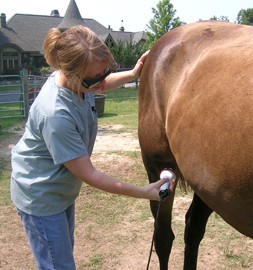Yes, it may sound like science fiction, but the latest weapon in the battle against chronic arthritis and pain in our companion animals isn’t a new supplement or a wonder drug or even hypnosis — it is something called Laser Therapy.
We are fortunate in this day and age to have a number of options available to treat pain and inflammation in our patients.
But sometimes pet owners can be limited in their choices due to their pets hitting a plateau in response to medication, dealing with underlying conditions that don’t allow medications to be utilized or even not being able to physically get the medications in (many pets are quite creative in their ability to resist medications!) Enter laser therapy…
Veterinarians use laser therapy to decrease pain, increase the rate of healing and minimize the damage that inflammation has on affected tissues. Just a few of the conditions in which laser therapy has been successful include arthritis, hot spots, intervertebral disc disease, cruciate ligament tears, hip dysplasia, lick granulomas, muscle/nerve pain, wounds, ear hematomas, feline stomatitis and snake bites.
Here’s how it works: Laser therapy utilizes a very specific wavelength of infrared light to penetrate injured tissues. When applied, the light waves activate an increase in energy production on a cellular level (think of it as using the laser to supercharge the cell’s internal processes). In this supercharged state, the cell has more energy to initiate a number of processes to decrease pain and inflammation, assist in wound healing and reduce scar tissue formation.
These processes include initiating the increase of blood flow to the affected areas, release of endorphins, activation of the body’s own anti-inflammatory cascades and decreasing painful nerve signals to decrease the pain experienced by your pet.
Treatments typically take less than 10 minutes per area and are completely non-invasive, painless and often pleasant for your pet. Treatment protocols depend on the chronicity of your pet’s condition, the individual response to therapy and the amount of damage that’s been done to the affected tissue. Most conditions take four to six treatments initially.
There are no deleterious side effects and laser can be used along with other treatment modalities, including medication, acupuncture, physical therapy, rehabilitation regimens and specialized diets and supplements. Although results range from subtle to miraculous, there is no question clients are seeing improvement in pain, mobility and quality of life of their pets.

